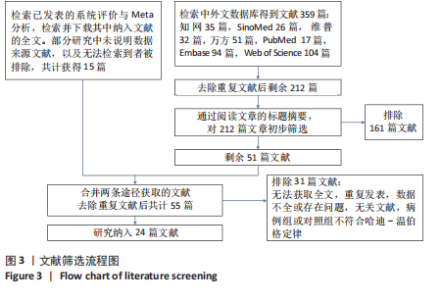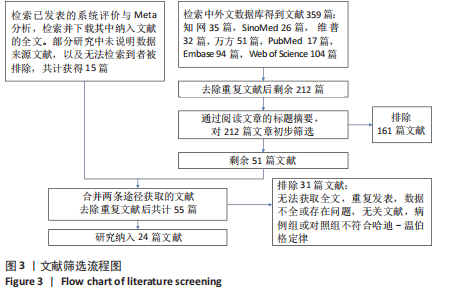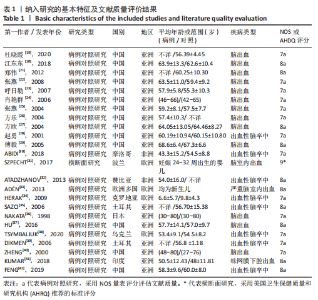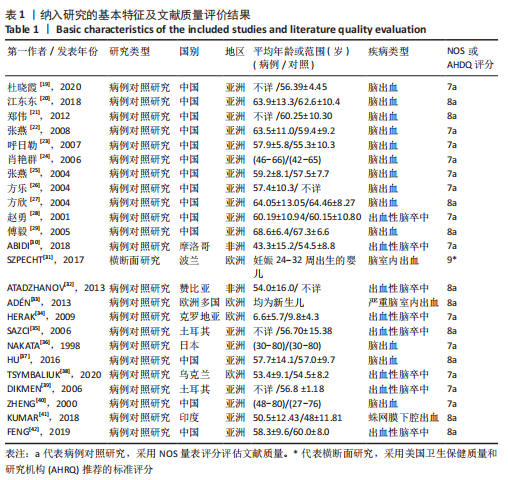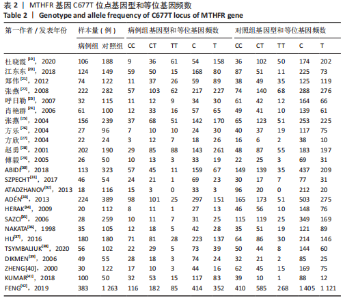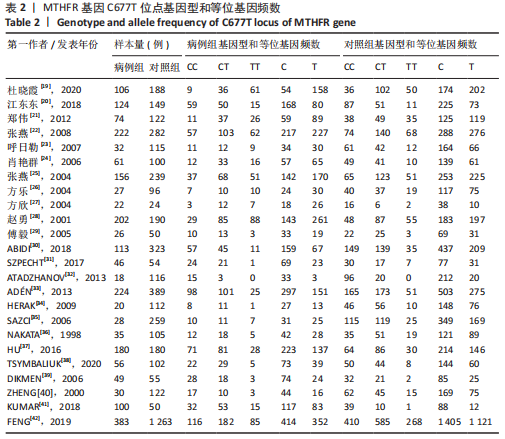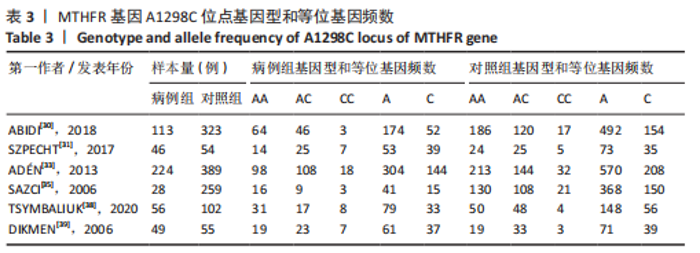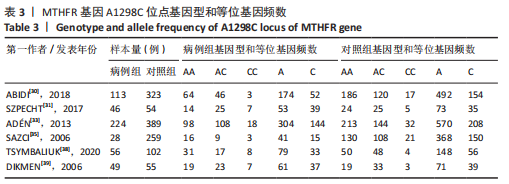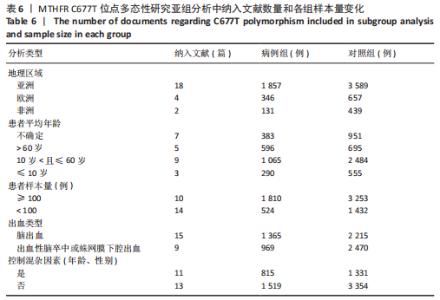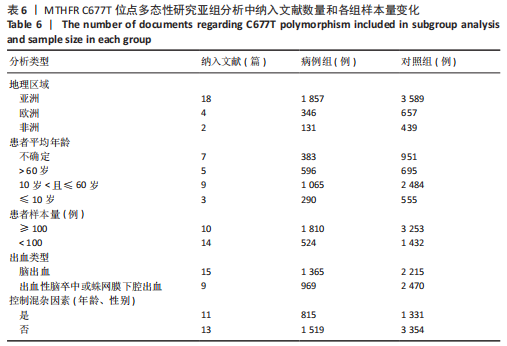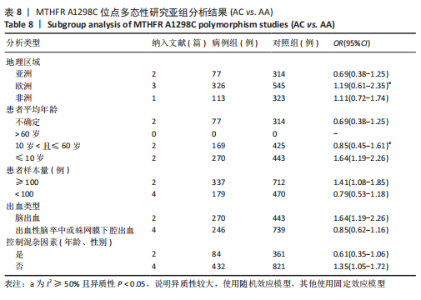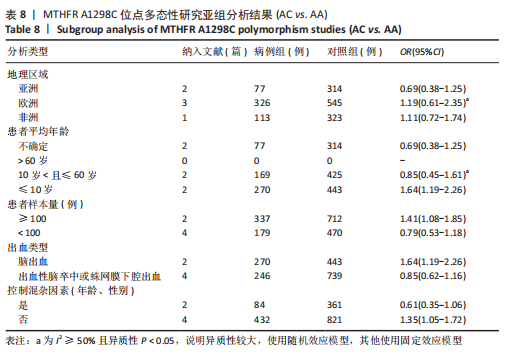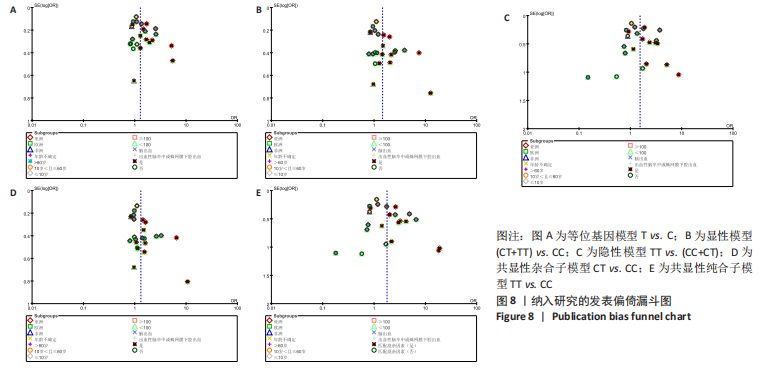Chinese Journal of Tissue Engineering Research ›› 2023, Vol. 27 ›› Issue (23): 3763-3772.doi: 10.12307/2023.583
Meta-analysis of the association between methylenetetrahydrofolate reductase gene polymorphisms and hemorrhagic stroke
Zhu Junjie1, Wang Haihuang2, Li Jianmin1, 3, Zhang Yuxin2, Liu Junjie1, 3
- 1School of Clinical Medicine, 2School of Basic Medicine, North China University of Science and Technology, Tangshan 063000, Hebei Province, China; 3Department of Neurosurgery, Affiliated Hospital of North China University of Science and Technology, Tangshan 063000, Hebei Province, China
-
Received:2022-08-19Accepted:2022-09-15Online:2023-08-18Published:2023-01-16 -
Contact:Liu Junjie, Lecturer, Master, Attending physician, School of Clinical Medicine, North China University of Science and Technology, Tangshan 063000, Hebei Province, China; Department of Neurosurgery, Affiliated Hospital of North China University of Science and Technology, Tangshan 063000, Hebei Province, China -
About author:Zhu Junjie, School of Clinical Medicine, North China University of Science and Technology, Tangshan 063000, Hebei Province, China -
Supported by:Innovation and Entrepreneurship Training Program for College Students of North China University of Science and Technology, No. X2021142 (to ZJJ); 2018 Hebei Health Technology Research and Achievement Transformation Key Project, No. zh2018015 (to LJM); Hebei Province Clinical Medicine Excellent Talents Training and Basic Research Project, No. 361036 (to LJM); Science and Technology Project of Tangshan City, No. 21130224C (to LJM); Medical Research Project of Hebei Provincial Health Commission, No. 20221533 (to LJM)
CLC Number:
Cite this article
Zhu Junjie, Wang Haihuang, Li Jianmin, Zhang Yuxin, Liu Junjie. Meta-analysis of the association between methylenetetrahydrofolate reductase gene polymorphisms and hemorrhagic stroke[J]. Chinese Journal of Tissue Engineering Research, 2023, 27(23): 3763-3772.
share this article
Add to citation manager EndNote|Reference Manager|ProCite|BibTeX|RefWorks
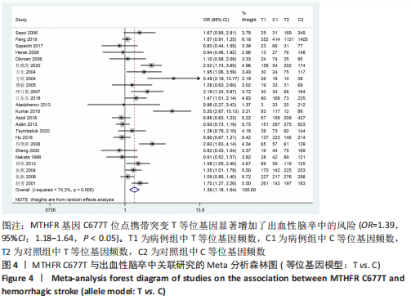
2.2 Meta分析结果 2.2.1 MTHFR基因C677T位点多态性与出血性脑卒中相关性 建立下述遗传模型分别进行分析,等位基因模型T vs. C,显性模型(CT+TT) vs. CC,隐性模型TT vs.(CC+CT),共显性杂合子模型CT vs. CC,共显性纯合子模型TT vs. CC。如表4所示,5种遗传模型均存在明显的研究异质性(I2≥50%,P < 0.05),因此采用随机效应模型分析。5种模型OR值与95%CI均大于1,有显著性意义(P < 0.05),显示出MTHFR C677T基因多态性与出血性脑卒中风险存在相关性,T等位基因携带者患出血性脑卒中的风险比CC纯合子的患病风险提高了39%,CT+TT基因型相较于CC基因型出血性脑卒中风险提高了46%,TT基因型相较于CC+CT基因型出血性脑卒中风险提高了54%,CT基因型相较于CC基因型出血性脑卒中风险提高了31%,TT基因型相较于CC基因型出血性脑卒中风险提高了78%。仅展示等位基因模型森林图,如图 4。"
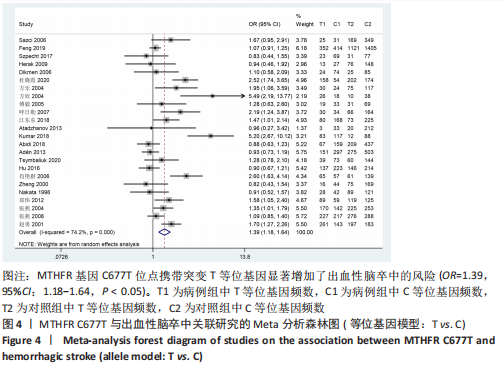
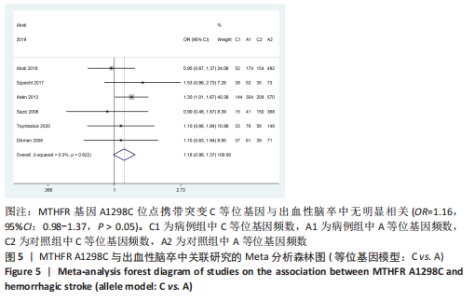
2.2.2 MTHFR基因A1298C位点多态性与出血性脑卒中风险 建立下述遗传模型分别进行分析,等位基因模型C vs. A,显性模型(CC+AC) vs. AA,隐性模型CC vs. (AC+AA),共显性杂合子模型AC vs. AA,共显性纯合子模型CC vs. AA。如表5所示,除隐性模型异质性较大采用随机效应模型外(I2≥50%,P < 0.05),其他遗传模型异质性均较小,采用固定效应模型分析(I2 < 50%,P > 0.05)。5种模型OR值的可信区间均包含1,OR值无显著性意义(P > 0.05),显示出MTHFR基因A1298C位点多态性与出血性脑卒中风险无明显统计学相关性。仅展示等位基因模型森林图,如图5。"
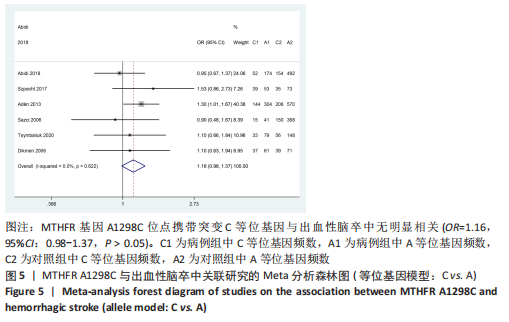
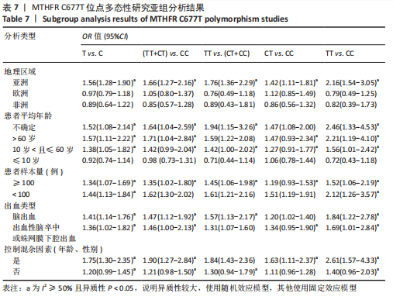
(1)依据地理区域分组分析结果表明,在亚洲地区的研究中,5种遗传模型OR值和95%CI均大于1,表现出 MTHFR C677T基因多态性与出血性脑卒中有明显的统计学相关性,但是各研究间异质性仍较大;与之不同的是在欧洲和非洲地区研究的异质性较小,MTHFR C677T基因多态性与出血性脑卒中无明显的统计学相关性,但是值得注意的是亚洲区域的研究纳入的样本量较多,欧洲和非洲纳入的样本量较少。 (2)依据患者平均年龄分组分析结果表明,在患者平均年龄> 60岁的人群中,5种遗传模型OR值和95%CI均大于1,表现出 MTHFR C677T基因多态性与出血性脑卒中有明显的统计学相关性,但是各研究间异质性仍较大;在≤10岁的人群的研究中,研究异质性较小且MTHFR C677T基因多态性与出血性脑卒中无明显的统计学相关性,但是样本量较少,且均为欧洲的研究。 (3)依据研究所纳入的患者样本量分组。在≥100例患者的研究中,尽管各研究间异质性较大,但是5种遗传模型均表现出 MTHFR基因C677T位点多态性与出血性脑卒中有明显的统计学相关性;在< 100例患者的研究中,共显性杂合子模型无显著性意义,其他4种遗传模型均有显著性意义,其中显性遗传模型和隐性遗传模型的研究间异质性明显减小。 (4)依据是否仅研究出血性脑卒中的脑出血进行分组,MTHFR C677T基因多态性与脑出血以及出血性脑卒中(脑出血+蛛网膜下腔出血)均有明显的统计学相关性,OR值和95%CI均大于1,除隐性遗传模型各研究间异质性较低,其他4种遗传模型异质性仍较高。 (5)依据纳入研究是否确保年龄和性别混杂因素在病例组和对照组中无统计学差异而进行亚组分析。结果表明,相较于未控制年龄和性别因素的研究,控制这两种因素后,5种遗传模型的OR值和95%CI均大于1,表现出 MTHFR C677T基因多态性与出血性脑卒中有明显的统计学相关性,且隐性遗传模型的研究间异质性明显降低。 亚组分析结果见表7。因此,MTHFR C677T基因研究多态性与出血性脑卒中的相关性研究间存在较大异质性的原因是多因素的,且对不同遗传模型的影响不同,亚组分析一定程度上降低了异质性。"
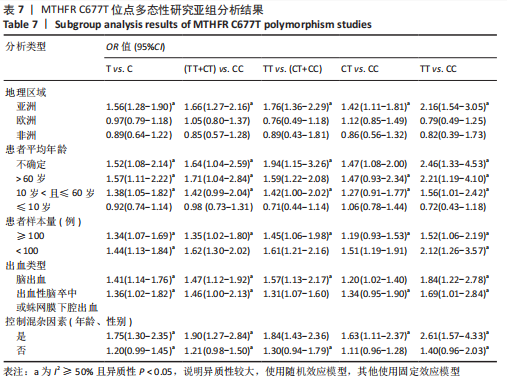
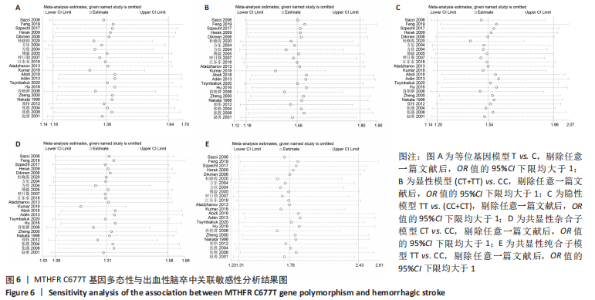
(1)依据地理区域分组,无统计学相关性。 (2)依据患者平均年龄分组。在≤10岁的人群中,AC基因型增加了出血性脑卒中风险(OR=1.64,95%CI:1.19-2.26)。 (3)依据研究所纳入的患者样本量分组。对样本量≥100例的研究中,表明AC基因型增加了出血性脑卒中风险(OR=1.41,95%CI:1.08-1.85)。 (4)依据是否仅研究出血性脑卒中的脑出血进行分组,在仅对脑出血研究中,携带C等位基因增加了脑出血的风险(OR=1.64,95%CI:1.19-2.26)。 (5)依据纳入研究是否确保年龄和性别混杂因素在病例组和对照组中无统计学差异而进行亚组分析。缺乏对年龄和性别匹配的研究显示携带C等位基因增加了出血性脑卒中风险(OR=1.35,95%CI:1.05-1.72)。 亚组分析后各组的异质性明显降低,但是样本量也减少,因此结论的可靠性降低。 2.4 敏感性分析结果 2.4.1 MTHFR C677T基因多态性与出血性脑卒中关联敏感性分析结果 此5种遗传模型分别进行敏感性分析,依次剔除一项文献研究,结果表明对最终的合并效应量OR值和95%CI范围影响不大,在可接受范围内,均大于1,说明该研究结果较稳定,MTHFR C677T基因多态性与出血性脑卒中有明显的统计学相关性,见图6。"
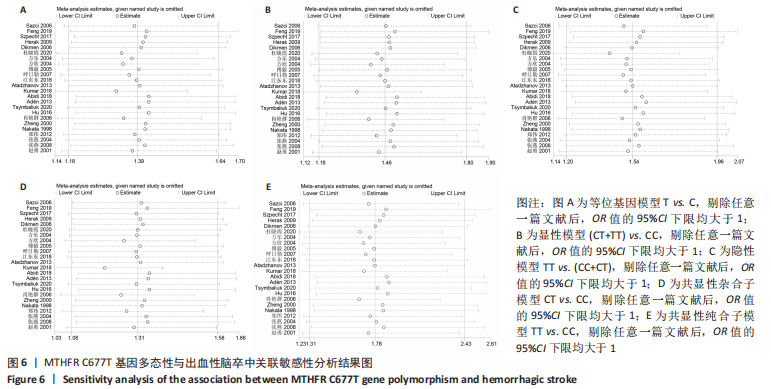
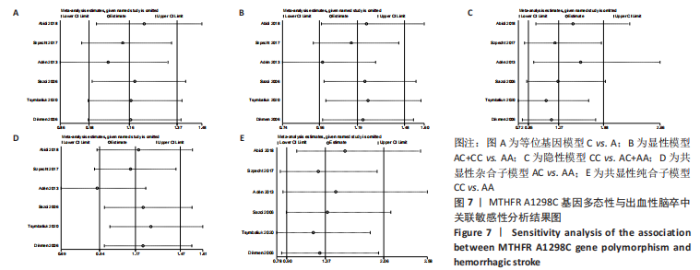
2.4.2 MTHFR A1298C基因多态性与出血性脑卒中关联敏感性分析结果 此 5种遗传模型分别进行敏感性分析,依次剔除一项文献研究。 (1)在等位基因遗传模型(C vs. A)中,当剔除ABIDI等[30]文献时,OR值和可信区间下限均大于1,出现明显波动,可见这篇文献具有较大的异质性,查阅该文献,发现该研究病例组与对照组的年龄差别大,分别是(43.3±15.2)岁和(54.5±8.8)岁,且性别比例差异较大,两组间其他混杂因素控制亦不明确,可能是异质性来源的原因。 (2)在显性遗传模型(AC+CC) vs. AA中,当剔除Tsymbaliuk等[38]文献时,OR值和可信区间下限均大于1,出现明显波动,可见这篇文献具有较大的异质性,查阅该文献,发现缺乏出血性脑卒中病例患者的一般基线资料,尚无法确定与对照组具备良好的可比性。 (3)在隐性遗传模型CC vs. (AA+AC)中,任意剔除一篇文献,OR值和可信区间波动在可接受范围内,结果较稳定。 (4)在共显性杂合子模型AC vs. AA中,当剔除TSYMBALIUK等[38]文献时,OR值和可信区间下限均大于1,出现明显波动,原因可能同(2)中所述。 (5)在共显性纯合子模型(CC vs. AA)中,当剔除ABIDI等[30]文献时,OR值和可信区间下限均大于1,出现明显波动,可见这篇文献具有较大的异质性,原因可能同(1)所阐述。 因此,相关研究较少,携带C等位基因以及CC基因型与出血性脑卒中的相关性仍待进一步研究,尚不能认为MTHFR A1298C基因多态性与出血性脑卒中存在相关性。敏感性分析结果见图7。"
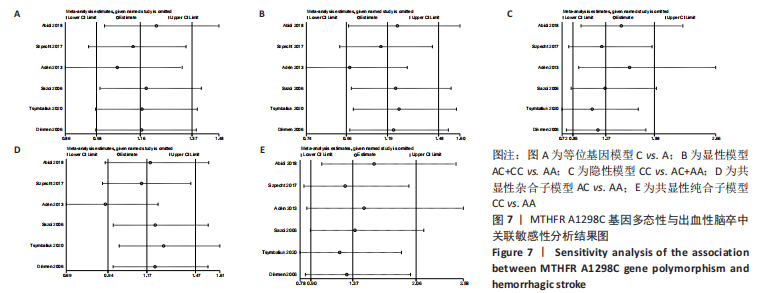
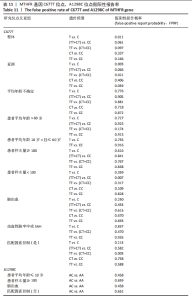
2.6 阳性结果的可信度分析 依据上述有显著性意义的结果的OR值和95%CI,计算对应模型的FPRP值,结果如表11所示。以FPRP值< 0.2为标准判断关联性可靠的标准。整体分析C677T位点,除CT vs. CC模型不满足外,其他模型均满足标准,整体说明C677T位点多态性与出血性脑卒中的关联结果可靠。进行亚组分析后,在亚洲人群中T vs. C和TT vs. (CT+CC)满足标准,在患者平均年龄> 60岁中TT vs. (CT+CC)满足标准,在患者样本量< 100例中(TT+CT) vs. CC满足标准,在匹配因素控制(是)中T vs. C和TT vs. (CT+CC)满足标准。由于亚组分析使得样本量减少,导致部分模型的假阳性概率提高,但是各亚组下均有满足条件的模型,因而提示C677T位点多态性与出血性脑卒中的关联结果较可靠。亚组分析中有显著性意义的A1298C位点多态性与出血性脑卒中的关联结果不满足标准,假阳性的可能性较大,结果不可靠。"
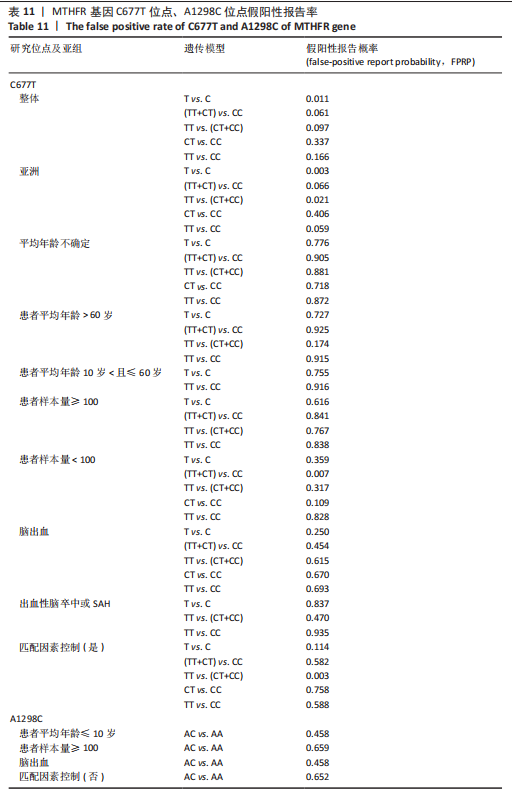
| [1] FEIGIN VL, STARK BA, JOHNSON CO, et al. Global, regional, and national burden of stroke and its risk factors, 1990–2019: a systematic analysis for the Global Burden of Disease Study 2019. Lancet Neurol. 2021;20(10):795-820. [2] LIU S, LIU M, LI Q, et al. Association of single nucleotide polymorphisms of MTHFR, TCN2, RNF213 with susceptibility to hypertension and blood pressure. Biosci Rep. 2019;39(12):BSR20191454. [3] 王慧,刘岩岩,张裕,等.MTHFR基因多态性与儿童原发性高血压的相关性研究[J].中国当代儿科杂志,2022,24(5):579-584. [4] WU H, HUANG Q, YU Z, et al. Association of ALDH2 rs671 and MTHFR rs1801133 polymorphisms with hypertension among Hakka people in Southern China. BMC Cardiovasc Disord. 2022;22(1):128. [5] CANDRASATRIA RM, ADIARTO S, SUKMAWAN R. Methylenetetrahydrofolate reductase C677T gene polymorphism as a risk factor for hypertension in a rural population. Int J Hypertens. 2020;2020: 4267246. [6] 魏守超,刘志辉,刘君玲.亚甲基四氢叶酸还原酶基因C677T多态性与中国山东地区汉族人群缺血性卒中、高尿酸血症的相关性[J].国际脑血管病杂志,2016, 24(11):1004-1009. [7] WEI W, LIU SY, ZENG FF, et al. Meta-analysis of the association of the C677T polymorphism of the methylenetetrahydrofolate reductase gene with hyperuricemia. Ann Nutr Metab. 2012; 60(1):44-51. [8] ZHAO X, JIANG H. Quantitative assessment of the association between MTHFR C677T polymorphism and hemorrhagic stroke risk. Mol Biol Rep. 2013;40(1):573-578. [9] LV Q, LU J, WU W, et al. Association of the methylenetetrahydrofolate reductase gene A1298C polymorphism with stroke risk based on a meta-analysis. Genet Mol Res. 2013;12(4):6882-6894. [10] WANG F, XU Z, JIAO H, et al. Associations between MTHFR gene polymorphisms and the risk of intracranial hemorrhage: evidence from a meta-analysis. Brain Behav. 2021;11(1):e1840. [11] MA S, FAN X, ZHAO X, et al. Risk factors for early-onset seizures after stroke: a systematicreview and meta-analysis of 18 observational studies. Brain Behav. 2021; 11(6):e2142. [12] LI X, HE J, YUN J. The association between serum vitamin D and obstructive sleep apnea:an updated meta-analysis. Respir Res. 2020;21(1):294. [13] 曾宪涛,刘慧,陈曦,等.Meta分析系列之四:观察性研究的质量评价工具[J].中国循证心血管医学杂志,2012,4(4):297-299. [14] 王霄玲,朱洁云,李柏成,等.BMI与宫颈癌发病风险的Meta分析[J].现代预防医学, 2020,47(8):1393-1398. [15] 林振南,贾砚慧,陈恕凤.脂蛋白(a)基因多态性与冠心病相关性的Meta分析[J].中国动脉硬化杂志,2022,30(2):152-160. [16] 谭颖超,杨珺玥,王莉娜.白细胞介素-1B-511C/T基因多态性与冠状动脉粥样硬化性心脏病关联的meta分析[J].上海交通大学学报(医学版),2022,42(2): 197-204. [17] WACHOLDER S, CHANOCK S, GARCIA-CLOSAS M, et al. Assessing the probability that a positive report is false: an approach for molecular epidemiology studies. J Natl Cancer Inst. 2004;96(6):434-442. [18] 翁鸿,张永刚,牛玉明,等.遗传关联性研究Meta分析的多重检验校正方法[J].中国循证心血管医学杂志,2016,8(12): 1409-1411. [19] 杜晓霞,肖琳,孙蓉,等.高同型半胱氨酸血症卒中患者高血压发病情况及疗效分析[J].北京医学,2020,42(5):379-382. [20] 江东东,盛文利,罗曼.中国南方汉族人群亚甲基四氢叶酸还原酶基因C677T多态性与脑出血的关系[J].临床神经病学杂志,2018,31(1):10-14. [21] 郑伟,杨智,安殿梅,等.脑血管病患者高同型半胱氨酸血症发生机制的初步研究[J].中国医科大学学报,2012,41(1): 69-72. [22] 张燕,谢汝萍,沈扬,等.亚甲基四氢叶酸还原酶基因C677T多态性与睡眠时间的相互作用对卒中的影响(英文)[J].北京大学学报(医学版),2008,40(3):262-269. [23] 呼日勒,赵世刚,牛广明,等.N5,10-亚甲基四氢叶酸还原酶基因多态性与蒙古族原发性高血压病及高血压病合并脑血管病的关系[J].卒中与神经疾病,2007, 14(1):13-15. [24] 肖艳群,蒋玲丽,陆青,等.亚甲基四氢叶酸还原酶基因多态性及血浆同型半胱氨酸水平与脑血管病的关系[J].检验医学,2006,21(3):201-204. [25] 张燕,谢汝萍,陈大方,等.亚甲基四氢叶酸还原酶基因多态性与脑出血的相关性研究[J].北京医学,2004,26(4):219-221. [26] 方乐,邬英全,王田蔚.中国北方汉族人体MTHFR和CBS基因多态性与脑梗死及脑出血遗传相关性的研究(英文)[J].中国临床康复,2004,8(22):4654-4656. [27] 方欣,洪震,任惠民,等.脑血管病病人MTHFR基因多态性和基因型对叶酸代谢、同型半胱氨酸代谢的影响[J].中华临床医药杂志,2004,5(1):5-9. [28] 赵勇,马丽媛,王兴宇,等.MTHFR基因C677T多态性与出血性脑卒中的关系[J].中国急救医学,2001,21(10):21-22. [29] 傅毅,刘建荣,倪培华,等.同型半胱氨酸及代谢酶基因多态性与脑卒中的相关性研究[J].中华老年医学杂志,2005,24(6): 413-417. [30] ABIDI O, HAISSAM M, NAHILI H, et al. Methylenetetrahydrofolate reductase gene polymorphisms (C677T and A1298C) and hemorrhagic stroke in moroccan patients. J Stroke Cerebrovasc Dis. 2018;27(7):1837-1843. [31] SZPECHT D, GADZINOWSKI J, SEREMAK-MROZIKIEWICZ A, et al. The role of FV 1691G > A, FII 20210G > A mutations and MTHFR 677C > T; 1298A > C and 103G > T FXIII gene polymorphisms in pathogenesis of intraventricular hemorrhage in infants born before 32 weeks of gestation. Childs Nerv Syst. 2017;33(7):1201-1208. [32] ATADZHANOV M, MWABA MH, MUKOMENA PN, et al. Association of the APOE, MTHFR and ACE genes polymorphisms and stroke in Zambian patients. Neurol Int. 2013;5(4):e20. [33] ADEN U, LIN A, CARLO W, et al. Candidate gene analysis: severe intraventricular hemorrhage in inborn preterm neonates. J Pediatr. 2013;163(5):1503-1506. [34] Herak DC, Antolic MR, Krleza JL, et al. Inherited prothrombotic risk factors in children with stroke, transient ischemic attack, or migraine. Pediatrics. 2009;123(4): e653-660. [35] SAZCI A, ERGUL E, TUNCER N, et al. Methylenetetrahydrofolate reductase gene polymorphisms are associated with ischemic and hemorrhagic stroke: dual effect of MTHFR polymorphisms C677T and A1298C. Brain Res Bull. 2006;71(1-3):45-50. [36] NAKATA Y, KATSUYA T, TAKAMI S, et al. Methylenetetrahydrofolate reductase gene polymorphism: relation to blood pressure and cerebrovascular disease. Am J Hypertens. 1998;11(8 Pt 1):1019-1023. [37] HU X, TAO C, XIE Z, et al. The MTHFR C677T polymorphism and risk of intracerebral hemorrhage in a Chinese Han population. Med Sci Monit. 2016;22:127-133. [38] TSYMBALIUK VI, VASYLIEVA IG, KOSTIUK MR, et al. Analysis of association between FGB, MTHFR, MTR and MTRR genes polymorphisms and ischemic and hemorrhagic stroke. Zaporozhye Med J. 2020;22(4):459-467. [39] DIKMEN M, OZBABALIK D, GUNES H V, et al. Acute stroke in relation to homocysteine and methylenetetrahydrofolate reductase gene polymorphisms. Acta Neurol Scand. 2006;13(5):307-314. [40] ZHENG YZ, TONG J, DO XP, et al. Prevalence of methylenetetrahydrofolate reductase C677T and its association with arterial and venous thrombosis in the Chinese population. Br J Haematol. 2000;109(4):870-874. [41] KUMAR M, GOUDIHALLI S, MUKHERJEE K, et al. Methylenetetrahydrofolate reductase C677T variant and hyperhomocysteinemia in subarachnoid hemorrhage patients from India. Metab Brain Dis. 2018,33(5):1617-1624. [42] FENG C, YANG Y, YANG S, et al. Effect of gene-gene and gene-environment interaction on the risk of first-ever stroke and poststroke death. Mol Genet Genomic Med. 2019;7(8):e846. [43] 贺婵婵,郭爱红,吴曼玲,等.MTHFR C677T和A1298C基因多态性的生物信息学分析[J].中国优生与遗传杂志,2021, 29(2):158-161. [44] BASZCZUK A, KOPCZYNSKI Z, THIELEMANN A. Dysfunkcja śródbłonka naczyniowego u chorych na pierwotne nadciśnienie tętnicze z hiperhomocysteinemią [Endothelial dysfunction in patients with primary hypertension and hyperhomocysteinemia]. Postepy Hig Med Dosw (Online). 2014;68: 91-100. [45] WU YL, HU CY, LU SS, et al. Association between methylenetetrahydrofolate reductase (MTHFR) C677T/A1298C polymorphisms and essential hypertension: a systematic review and meta-analysis. Metabolism. 2014;63(12):1503-1511. [46] MENG H, HUANG S, YANG Y, et al. Association between MTHFR polymorphisms and the risk of essential hypertension: an updated meta-analysis. Front Genet. 2021;12:698590. [47] 余灿清,李立明. 假阳性结果报告率在分子流行病学研究中的应用[J].中华预防医学杂志,2009,43(12):1141-1142. |
| [1] | Wang Yanjin, Zhou Yingjie, Chai Xubin, Zhuo Hanjie. Meta-analysis of the efficacy and safety of 3D printed porous titanium alloy fusion cage in anterior cervical discectomy and fusion [J]. Chinese Journal of Tissue Engineering Research, 2023, 27(9): 1434-1440. |
| [2] | Jiang Xiaocheng, Shi Lu, Wang Yinbin, Li Qiujiang, Xi Chuangzhen, Ma Zefeng, Cai Lijun. Systematical evaluation of bone fusion rate after interbody fusion in patients with osteoporosis and lumbar degenerative disease treated with teriparatide [J]. Chinese Journal of Tissue Engineering Research, 2023, 27(9): 1427-1433. |
| [3] | Li Wenjie, You Aijia, Zhou Junli, Fang Sujuan, Li Chun. Effects of different dressings in the treatment of burn wounds: a network meta-analysis [J]. Chinese Journal of Tissue Engineering Research, 2023, 27(7): 1141-1148. |
| [4] | Chen Guanting, Zhang Linqi, Li Qingru. Meta-analysis of the value of exosomal miRNA for the diagnosis of chronic kidney disease [J]. Chinese Journal of Tissue Engineering Research, 2023, 27(6): 970-976. |
| [5] | Yan Le, Zhang Huiping, Dai Lintong. Mesenchymal stem cells for allergic rhinitis: a meta-analysis based on animal experiments [J]. Chinese Journal of Tissue Engineering Research, 2023, 27(6): 977-984. |
| [6] | Zhou Yinan, Yang Kun, Jiang Jiayi, Zhang Sizhuo, Zhu Yingwen. The relationship between glucose transporter 1/4 gene polymorphisms and athletic ability [J]. Chinese Journal of Tissue Engineering Research, 2023, 27(5): 745-750. |
| [7] | Feng Liang, Gong Shuhui, Huo Hongfeng. Effect of short-foot training on foot and ankle function in patients with flat feet: Meta-analysis and systematic review [J]. Chinese Journal of Tissue Engineering Research, 2023, 27(5): 799-804. |
| [8] | Pan Weimin, Wang Bing, Han Yabing, Li Ting, Song Jiaqi, Qin Huasheng, Liu Yang. Effects of blood flow restriction training on muscle strength, muscle mass and physical performance in older adults: a Meta-analysis [J]. Chinese Journal of Tissue Engineering Research, 2023, 27(5): 805-812. |
| [9] | Yu Jiaan, Liu Xinwei, Lian Hongyu, Liu Kexin, Li Zitao. Medial open-wedge tibial osteotomy versus lateral closed-wedge tibial osteotomy for unicompartmental knee osteoarthritis: a meta-analysis [J]. Chinese Journal of Tissue Engineering Research, 2023, 27(4): 632-639. |
| [10] | Xu Yangyang, He Peiliang, Meng Qingqi, Li Siming. A meta-analysis of the effects of continuous adductor canal block and continuous femoral nerve block on early activity after knee arthroplasty [J]. Chinese Journal of Tissue Engineering Research, 2023, 27(4): 640-645. |
| [11] | Chai Hao, Yang Deyong, Zhang Lei, Shu Li. 3D printing personalized osteotomy guide technology versus conventional total knee arthroplasty on the accuracy of lower limb force alignment: a meta-analysis [J]. Chinese Journal of Tissue Engineering Research, 2023, 27(4): 646-654. |
| [12] | You Aijia, Li Wenjie, Zhou Junli, Li Chun. Systematic evaluation of six dressings on wound safety following total hip and knee arthroplasty [J]. Chinese Journal of Tissue Engineering Research, 2023, 27(3): 486-492. |
| [13] | Ma Maoxiao, Cui Guofeng, Zhang Xue, Zhang Hong, Liu Youwen, Yue Chen. Complications after spinal fusion in patients with metabolic syndrome: a systematic review and meta-analysis [J]. Chinese Journal of Tissue Engineering Research, 2023, 27(22): 3602-3608. |
| [14] | Yin Yikun, Wang Jialin, Sun Junzhi. Therapeutic effect of different-frequency repetitive transcranial magnetic stimulations on post-stroke cognitive impairment: a Meta-analysis [J]. Chinese Journal of Tissue Engineering Research, 2023, 27(20): 3274-3280. |
| [15] | Wu Yihan, Wei Qiaoye, Pang Yu, Liu Zhongqiang. Proprioception characteristics of functional ankle instability: a meta-analysis [J]. Chinese Journal of Tissue Engineering Research, 2023, 27(18): 2943-2952. |
| Viewed | ||||||
|
Full text |
|
|||||
|
Abstract |
|
|||||
